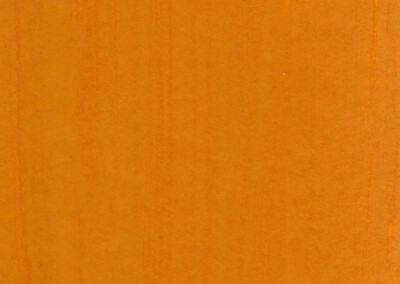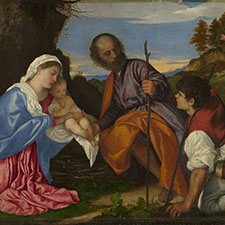Titian, The Aldobrandini Madonna
ca 1532Titian, The Aldobrandini Madonna
ca 1563Paintings sorted by Historical period | Painter | Subject matter | Pigments used
Overview
Medium: Oil
Support: Canvas
Size: 100.6 x 142.2 cm
Art period: High Renaissance
National Gallery London
NG 635
Provenance: The Aldobrandini Madonna, Mapping Paintings
Pigments
Pigment Analysis
This pigment analysis is based on the work of the scientists at the National Gallery London (1). The scientists employed IR-reflectography (IRR), x-radiography (XRR) and high pressure liquid chromatography (HPLC) to gain insights into the inner layers of the painting, to discover alterations made in the course of the work (pentimenti) and to identify the pigments.

1 Virgin’s blue drapery: underlayer of brown ochre with some natural ultramarine and a copper-containing pigment (azurite, malachite, or verdigris) overpainted with high-quality natural ultramarine mixed with lead white. The deep shadows contain almost no lead white.
2 Child’s flesh colour: underlayer of lead white and red ochre overpainted with lead white mixed with vermilion and some red ochre and traces of red lake.

3 Saint’s yellow dress: the dress is painted in the cangiante style* and should depict yellow silk with a violet tint. The whole dress is underpainted with a purple layer, the upper layer contains lead-tin yellow.

4 Brownish-green foliage above Saint John’s cross: underpaint based on red ochre mixed with yellow ochre overpainted with several layers of verdigris with varying proportions of ochres and lead-tin yellow.
5 Green leaves in the foliage: underlayer of verdigris mixed with yellow ochre and a little lead white and traces of red ochre. The top layers consist of verdigris, lead-tin yellow, and lead white.

*cangiante painting style: one of the Renaissance painting styles. The painter uses a pigment of a different colour if the original colour cannot be made light enough or, conversely, dark enough. The term has its origin in the Italian word cangiare meaning to change.
References
(1) Jill Dunkerton and Marika Spring, with contributions from Rachel Billinge, Kamilla Kalinina, Rachel Morrison, Gabriella Macaro, David Peggie and Ashok Roy, Titian’s Painting Technique to c.1540, National Gallery Technical Bulletin, volume 34, 2013, pp. 4-31. Available as pdf. Catalog part II pp. 86-91. Available as pdf.
Pigments Used in This Painting
Resources
See the collection of online and offline resources such as books, articles, videos, and websites on Titian in the section ‘Resources on Painters‘
PowerPoint Presentations
Painter in Context: Titian
A richly illustrated presentation on the Venetian Renaissance painter Titian (Tiziano Vecellio) containing information on painting technique, pigments employed, and important written and online resources.
Number of slides: 23
Formats included in the download: PowerPoint Screen Presentation (ppsx) and pdf
Publications and Websites
Publications
(1) Jill Dunkerton and Marika Spring, with contributions from Rachel Billinge, Kamilla Kalinina, Rachel Morrison, Gabriella Macaro, David Peggie and Ashok Roy, Titian’s Painting Technique to c.1540, National Gallery Technical Bulletin, volume 34, 2013, pp. 4-31. Available as pdf. Catalog part II pp. 86-91. Available as pdf.
Websites
Boston University, Mapping Titian, Aldobrandini Madonna, (gives the history of locations and owners of this painting).























